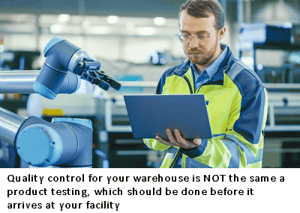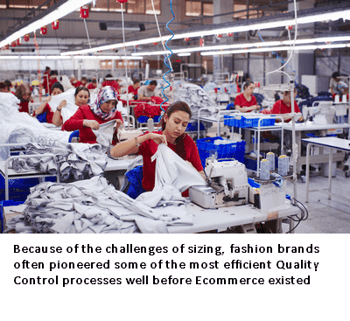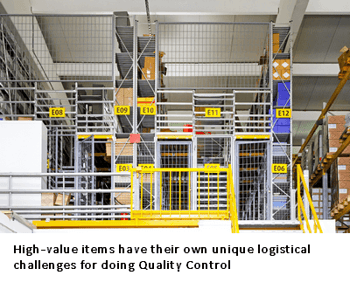
One warehouse process that we don’t see discussed as frequently as we’d expect would be Quality Control (QC). While the need for QC for the products coming into the warehouse varies by industry or types of products, it tends to be overlooked in many of those places where you would expect to see it.
If any of the following scenarios applies to what you do in your facility, then read on, this could be something that helps:
- You sell products are received directly from 3rd party manufacturing partners
- You have products that have a traditionally high return rate
- You have products that have high price points and are kept in secure storage
There are other scenarios that apply as well, but let’s prioritize covering these more common ones:
Quality Control Basics
First, for almost any scenario, understanding the basics of what QC is and what it is NOT are important!

- It is NOT “product testing”. If your products require testing they should be tested in a proper testing facility of your own or with a 3rd party, using guidelines and KPIs established for those products.
- MOST of the time you do not need to inspect EVERYTHING. Depending on your business, you’ll know where the trouble spots are, so focus there.
- Make sure you have the process mapped out all the way through the outcomes. What happens to products that fail? Can you fix them on site? Do they get sent back or put on “Clearance”? Or does the whole shipment go back?
- And what’s required to do it right? It’s not always something anyone can do. So make sure you not only have protocols in place but the resources to train for them too, as needed.
Scenario 1 – 3rd Party Manufacturers
For this example, we’ll look at the clothing industry, where MOST “brands” out there do not own their own manufacturing resources but focus on design and merchandising and outsourcing the actual production to dedicated textile manufacturers (largely in Asia). For this kind of arrangement, you would have pre-determined quality KPIs that allow for a certain amount of defects (it’s not always realistic to expect 100% perfect merchandise). The agreement would also specify what happens to items that do not pass inspection in your QC process – often a refund for the defective items or even a right to return the entire shipment.

Your process would look like this:
- QC staff planning ahead for incoming shipments and identifies the products coming in
- Reference guidelines for QC and staff accordingly
- Guidelines would include “remove X% of each SKU/Color/Size for inspection” (i.e. 10%), and then set a triggers for further action.
- If initial inspection of products exceeds allowed criteria, it may trigger a larger inspection in stages (i.e. 50% followed by 100%).
- Based on pre-agreed terms, package up rejects, or WHOLE shipment to return to manufacturer and get credit for the return (or you may have agreement to dispose of them as clearance or recycle).
- Once QC is completed, return to original cases and pallets and signal to putaway operator that shipment can be slotted in destination (reserve or directly in picking).
Don’t forget that if you can codify this process in your WMS you should, that way the inventory will be visible being in “limbo” in QC.
AND….you can be creative about how to deal with the problems. One insider at a clothing company has some great stories including once flying seamstresses in from the manufacturer in Italy to repair a flaw in the shoulder of a shipment of cashmere sweaters that had been highly anticipated for a coming catalog!
Scenario 2 – High Return Rates
While clothing, and especially women’s clothing, is known for having the highest return rates in the industry, this results mostly from sizing issues, which is why over the years websites have put so much energy into detailed sizing charts and instructions. It’s also why these industries frequently led the “unconditional guarantee” movement well before the advent of Ecommerce. Shoes and bathing suits, for example, can have return rates of over 50%.

But for other products like electronics can have returns rates of 25% or more. For products like this, where “wrong size” is generally NOT the reason, your QC process should focus on the specific, most common reasons for return.
If there are specific defects popping up that are responsible for the returns, then in this case it would make sense to work out a protocol where those features can be tested. But even in this case, it would be better to hold the manufacturer accountable for improving the testing they may already be doing.
Scenario 3 – High Value Merchandise
High-value merchandise has its own unique challenges. If you are selling jewelry with precious stones, for example, then you are not likely to be doing these inspections on an open area near the Receiving dock. But almost like a police evidence locker, you may need a “chain of custody” that gets these items to a workspace where your QC can be conducted. And for small volume/high-value items like jewelry, it is also an opportunity to enhance security on these items by applying RFID tags to them which can speed up cycle counts and monitor their movements in (and out of) the facility.
QC for items like this will often require very specific skills that are not always trainable on site. For these items (especially if they are kept in a locked cage or other secure areas), you may want to consider setting up on a different site nearby if you can’t make the logistics of secure, on-site location work.
If these items are seasonal or not typical of your product offering, consider having a contractor be your QC lead, someone with the expertise and industry background who can do this more efficiently and accurately than you can do on your own.
Make Quality Control Its Own Process
The point here is to start looking at this process in a more formal manner. The benefits go beyond just reducing the number of items going into inventory that might be defective. As we pointed out in this earlier article, a good Quality Control process is a way to gain new efficiencies and productivity up and down the customer journey.
And your QC people can do double duty by being top-notch Returns people who can efficiently do the product evaluations as they come back into the warehouse.










